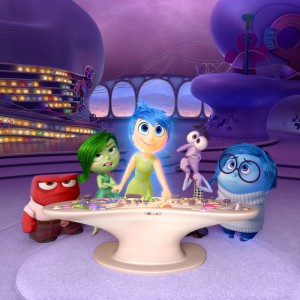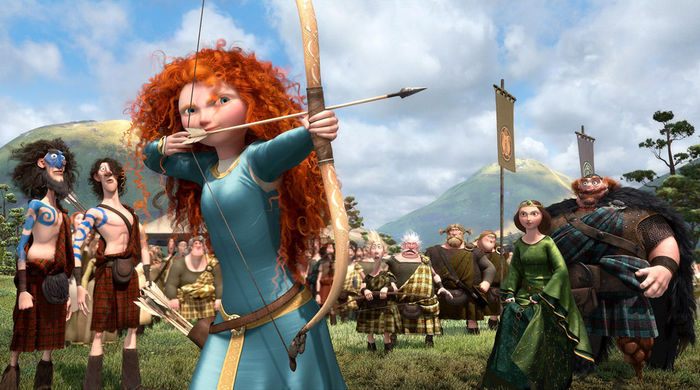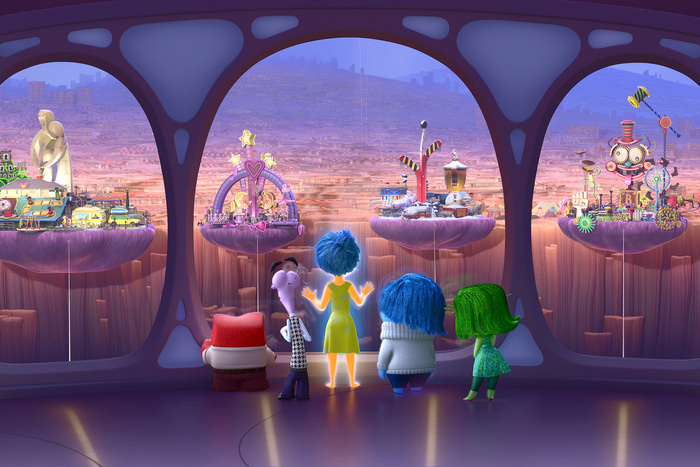In addition to the general cleverness and cuteness Inside Out automatically inherits as a member of the Pixar gene pool, the movie has two unique traits that launch it into a league apart from its siblings. For one thing, there’s the solidity of the actual science bedecked by the typical cuteness and cleverness. And just as importantly, there’s its peerless treatment of a female protagonist. Yes, Brave, not Inside Out, holds the distinction of being Pixar’s first ever female-led movie. It’s just that Inside Out does it better.
First, for the science. Inside Out is a love letter to the brain, written in a language kids will take to right away. It may have been cutened up, but it is certainly not dumbed down. This is a movie, after all, that comfortably contains both a character named Bing Bong and a visual representation of abstract thought rendered through cubism.
 In Inside Out, main character Riley’s brain is home (or “Headquarters”) to the five anthropomorphized emotions that govern her responses to everyday life. Pixie-ish Joy (voiced by Amy Poehler) and adorably downtrodden Sadness (Phyllis Smith) share the space with colleagues Disgust, Anger, and Fear. All work in perfect harmony (with Joy mostly holding the reins) until a cross-country move upsets the happy consistency of young Riley’s emotions.
In Inside Out, main character Riley’s brain is home (or “Headquarters”) to the five anthropomorphized emotions that govern her responses to everyday life. Pixie-ish Joy (voiced by Amy Poehler) and adorably downtrodden Sadness (Phyllis Smith) share the space with colleagues Disgust, Anger, and Fear. All work in perfect harmony (with Joy mostly holding the reins) until a cross-country move upsets the happy consistency of young Riley’s emotions.
All of this spells trouble at Headquarters. The collected experiences of Riley’s young, stable life contain no precedent for dealing with the emotional magnitude of a family move. Her emotions’ usual tricks for restoring her happiness (replaying warm memories, stimulating her inner goofball) prove useless one by one, and chaos ensues. In one particularly heated tussle, Joy and Sadness stray too close to the opening that connects Headquarters to the rest of Riley’s brain. It’s a tube of sorts, a kind of superhighway that sucks recently made, marble-like memories into the brain’s outer reaches, either to be forgotten or temporarily shelved. Joy and Sadness are fighting over control of Riley’s core memories—the only kind of memories permanently housed in Headquarters. ince they have all been happy up until this point, their safekeeping is Riley’s strongest bastion against despair.
It doesn’t end well. Joy, Sadness, and all of the core memories whose safekeeping they were just arguing over are pulled out of Headquarters and into the neurological hinterlands. What alarms them most about this accidental exile, though, is not that they’ll have to journey through the complex topography of Riley’s brain in order to get back. It’s that without her positive core memories (and most importantly, they think, without Joy), Riley has no chance of being happy again. Determined not to accept this fate, the two emotions embark on the long journey home: down aisles of densely shelved memories, into the Oz-like suburbs of Imagination Land, through the rarified atmosphere of Abstract Thought, across the studio-lot bustle of Dream Productions. In the process, the unlikely pair learns just what it will take to make Riley happy again—a job, it turns out, that Joy can’t do on her own.
The movie may seem like a Candy Land interpretation of what’s happening in all of our minds, but it maintains a devoted commitment to scientific accuracy. From movie reviews to editorials written by the psychologists who consulted on the film, it’s clear that Inside Out isn’t just that coveted breed of children’s movie that satisfies adults as well as kids. Turns out neuroscientists are in good hands with this one, too.
 And, for that matter, feminists.. Any discussion of feminist themes in Inside Out must first, rightfully so, start with a look at Brave, Pixar’s 2012 ode to girl power set in the Scottish Highlands. Despite opening numbers lower than what box-office giant Pixar has come to expect, Brave was still a creative and critical success, and this was thanks, in large part, to the excitement over the film’s heroine, Merida. She’s a horseback-riding archery master who wrangles with her feisty little brothers and isn’t afraid to get her glorious curls tangled up on woodsy quests. When forced to attend an archery competition aimed at finding her a husband amongst the young men of the neighboring clans, petite Merida counters, “I’ll be shooting for my own hand.” And she does, needless to say, besting all boys in attendance.
And, for that matter, feminists.. Any discussion of feminist themes in Inside Out must first, rightfully so, start with a look at Brave, Pixar’s 2012 ode to girl power set in the Scottish Highlands. Despite opening numbers lower than what box-office giant Pixar has come to expect, Brave was still a creative and critical success, and this was thanks, in large part, to the excitement over the film’s heroine, Merida. She’s a horseback-riding archery master who wrangles with her feisty little brothers and isn’t afraid to get her glorious curls tangled up on woodsy quests. When forced to attend an archery competition aimed at finding her a husband amongst the young men of the neighboring clans, petite Merida counters, “I’ll be shooting for my own hand.” And she does, needless to say, besting all boys in attendance.
And yet.
There’s no doubting that Merida is an independent woman of the first degree, but there are no groundbreaking feminist themes in the first half of Brave. Merida’s “I can do anything boys can do” exploits are satisfying, but they’re also old-hat. There’s nothing here that a young girl in the audience couldn’t get from a rental of 1998’s Mulan.
Brave’s feminist heart lies not in the focus on Merida’s archery skills, but the inclusion of a meaty storyline with her mother at the point where a romantic plot would typically kick in. What makes the movie fall short of revolutionary is that this relationship is layered deep under an all-caps theme of GIRLPOWER. Brave’s’s loud inclusion of this kind of one-note, kick-butt feminism is an obvious play for female agency, but it’s not the most feminist part of the movie. In reality, that title goes to the Bechdel-test-acing latter half of the film. Merida and her mom are equally smart, strong, and loving, and it’s their confrontations (and ultimate reconciliation) that provide the movie’s beating heart. (And pave the way for Disney’s wildly successful sister-act Frozen.)
Inside Out, on the other hand, has no hidden feminist core because it wears its subtle feminism on its sleeve. All of the science, and the art, at play in its scenes are in service of telling a story about feelings. A girl’s feelings. Not something Hollywood usually does well, if it attempts to do so at all. And yet Inside Out succeeds because it’s a movie entirely about the goings-on inside a girl’s head that doesn’t gain its structure from gender stereotypes.
Yes, Riley has boyfriend fantasies and a soft spot for teen vampire romance, but her love for hockey is what gets central billing. And still, Inside Out is deft in the way it trains its focus on the role of hockey in Riley’s life. The inclusion of her talent for the sport feels neither cursory nor overly weighted. In short, it’s not the kind of token offering Brave makes to the GIRLPOWER gods, and it’s not so meaningful that it’s what her agency as a person depends upon.
Most importantly, the existence of all of these interests (sports, boys, romance novels) simultaneously in a girl’s mind is a nonevent for most kids watching Inside Out today. The movie rightfully treats them as such. In the end, even hockey doesn’t come close to defining Riley’s personality in the way “family” and “honesty” do—the two “personality islands,” to use Inside Out lingo, that are most shaken by her emotional turmoil. The importance of maintaining these two inner tenets against an onslaught of outer stresses can resonate with all audience members, adults and children alike. Inside Out’s spot-on, stylized take on the actual science behind all of our minds is, in part, to thank for this broad appeal. But another facet of Inside Out’s strength is feminist. It sets a universal story inside the complex mind of a young woman, and in doing so, it treats Riley like a person first and a girl second, not the other way around.
Images via Disney.


